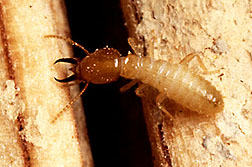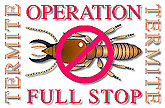|

A Formosan subterranean termite
soldier. Click the image for more information about it.

Learn about Operation FullStop, the
National Formosan Subterranean Termite Program.
|
USDA's Gentle, But Tough, Termiticide Now
Patented By Erin
Peabody
March 22, 2004
The latest weapon in the war on termites--a toxic bait that's
tasty to termites--has been patented by U.S. Department of Agriculture (USDA)
scientists. This means that the low-dose termiticide is a step closer to
reaching homeowners and others trying to put a stop to the wood-eating pest.
Formosan subterranean termites alone cost Americans about $1 billion every year
in control and repair costs.
The new termiticide contains low concentrations of naphthalenic
compounds similar to those used in mothballs. Researchers with USDA's
Agricultural Research Service and
Forest Service have found that, even at low
doses, the termiticide helps control native Eastern subterranean termites, in
addition to the more notorious Formosan subterranean termite.
The product was tested by entomologists M. Guadalupe Rojas and
Juan A. Morales-Ramos of the ARS Southern Regional Research Center (SRRC) in New
Orleans, La., and by microbiologist Frederick Green III of the Forest Service's
Forest Products Laboratory in Madison, Wis.
Green and his colleagues with the Forest Service were seeking
replacements for wood preservatives that contain heavy metals such as arsenic,
chromium and copper. Through his research, Green found that certain
naphthalenic compounds not only prevented wood decay, but also killed native
termite colonies.
Green collaborated with SRRC's Rojas and Morales because of
their knowledge of termite nutritional preferences. The SRRC researchers were
able to incorporate the naphthalenic compounds into a cellulose-based matrix--a
slow-acting toxic bait that appeals to termites' tastebuds, which encourages
wider distribution throughout the colony.
Because they're effective at low doses, the termite-killing
compounds are both environmentally friendly and cost-effective, according to
ARS researchers.
Rojas and Morales are located in SRRC's
Formosan
Subterranean Termite Research Unit. One of the research program's key
strategies is deploying toxic baits to reduce termite populations.
ARS is the USDA's chief
scientific research agency. |